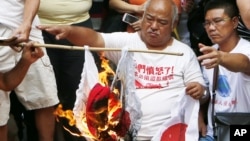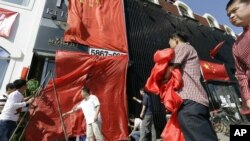BEIJING —
As anti-Japanese protests spread in China and in some cases turn violent, Chinese Web users are questioning when the actions of protesters go too far.
Although protests in Beijing were mostly peaceful, some carried extreme messages.
“Even if all China becomes a grave, we must kill every Japanese,” read a banner at the front of a group of marching protesters near the Japanese embassy on Sunday.
In other cities, demonstrations took a violent turn. In the Southern city of Guangzhou rioters forced their way into a hotel attached to the Japanese consulate, smashing windows and hanging banners. In other cities, Japanese goods including cars and cell-phones were damaged and burned in public displays of anger.
The Chinese government has publicly condemned such violence, but otherwise showed tolerance towards the demonstrations.
On Monday, a commentary on the front page of the Communist Party’s mouthpiece, the People’s Daily, acknowledged that China had been provoked by Japan, and thus people’s anger was “irrepressible.”
“These patriotic feelings are precious, and they must be cherished and protected,” the article read, but it also warned against inappropriate forms of protests. “A civilized attitude abiding by rule of law should be the basic conduct of the citizenry.”
The op-ed echoed calls for calm by other news outlets. State news agency Xinhua said that Chinese indignation over Japan’s nationalization of the Diaoyu Islands was “a reasonable move and a natural reaction,” but advised people to be wise in the expression of their patriotism.
On Weibo, China’s most widely used micro blog service, many users shared their views on patriotism on Monday.
A young Japanese citizen living in China reported on his Weibo account that he had just been charged by a group of Chinese people, while he was helping victims of the recent earthquake in China’s Guizhou province. “I am not physically hurt, but I am broken hearted,” he wrote.
“Let’s be reasonable patriots,” a Weibo user from Liaoning province wrote in response. “Not all Japanese people are right wing extremists, patriotic sentiments can spread at times but real patriotism is not expressed by beating Japanese people,” he added.
Lian Yue, a freelance writer and columnist posted a message on his micro blog account challenging the idea of reasonable patriotism. “Patriotism itself means conducting unreasonable actions,” he wrote. “If the dam burst, there is no survivor left,” he added.
Fei Fei, a 27 years old Chinese employee in a Beijing-based Japanese firm, says that she agrees with what protesters stand for, and thinks of them as patriotic, but adds her reservations when it comes to violent acts against Japanese people or businesses.
“Violence is never a good way to solve things,” she says and adds that it should be up to the two countries’ governments to set up dialogue and resolve the issue. “You cannot have citizens struggle on these very weird political situations,” she says.
Japan said that it decided to buy the contested territory to deflect further tensions, after Tokyo’s right wing governor Shintaro Ishihara had announced his interest in purchasing the islets. But in China, the move was perceived to have broken an unspoken understanding that both countries would not take overt measures to demonstrate their claims over the Diaoyu Islands, Senkaku in Japanese.
The Chinese government, which faces an unusually uncertain political transition in October and has been dealing with less than ideal economic figures in recent months, is wary of protests spinning out of control.
Although protests in Beijing were mostly peaceful, some carried extreme messages.
“Even if all China becomes a grave, we must kill every Japanese,” read a banner at the front of a group of marching protesters near the Japanese embassy on Sunday.
In other cities, demonstrations took a violent turn. In the Southern city of Guangzhou rioters forced their way into a hotel attached to the Japanese consulate, smashing windows and hanging banners. In other cities, Japanese goods including cars and cell-phones were damaged and burned in public displays of anger.
The Chinese government has publicly condemned such violence, but otherwise showed tolerance towards the demonstrations.
On Monday, a commentary on the front page of the Communist Party’s mouthpiece, the People’s Daily, acknowledged that China had been provoked by Japan, and thus people’s anger was “irrepressible.”
“These patriotic feelings are precious, and they must be cherished and protected,” the article read, but it also warned against inappropriate forms of protests. “A civilized attitude abiding by rule of law should be the basic conduct of the citizenry.”
The op-ed echoed calls for calm by other news outlets. State news agency Xinhua said that Chinese indignation over Japan’s nationalization of the Diaoyu Islands was “a reasonable move and a natural reaction,” but advised people to be wise in the expression of their patriotism.
On Weibo, China’s most widely used micro blog service, many users shared their views on patriotism on Monday.
A young Japanese citizen living in China reported on his Weibo account that he had just been charged by a group of Chinese people, while he was helping victims of the recent earthquake in China’s Guizhou province. “I am not physically hurt, but I am broken hearted,” he wrote.
“Let’s be reasonable patriots,” a Weibo user from Liaoning province wrote in response. “Not all Japanese people are right wing extremists, patriotic sentiments can spread at times but real patriotism is not expressed by beating Japanese people,” he added.
Lian Yue, a freelance writer and columnist posted a message on his micro blog account challenging the idea of reasonable patriotism. “Patriotism itself means conducting unreasonable actions,” he wrote. “If the dam burst, there is no survivor left,” he added.
Fei Fei, a 27 years old Chinese employee in a Beijing-based Japanese firm, says that she agrees with what protesters stand for, and thinks of them as patriotic, but adds her reservations when it comes to violent acts against Japanese people or businesses.
“Violence is never a good way to solve things,” she says and adds that it should be up to the two countries’ governments to set up dialogue and resolve the issue. “You cannot have citizens struggle on these very weird political situations,” she says.
Japan said that it decided to buy the contested territory to deflect further tensions, after Tokyo’s right wing governor Shintaro Ishihara had announced his interest in purchasing the islets. But in China, the move was perceived to have broken an unspoken understanding that both countries would not take overt measures to demonstrate their claims over the Diaoyu Islands, Senkaku in Japanese.
The Chinese government, which faces an unusually uncertain political transition in October and has been dealing with less than ideal economic figures in recent months, is wary of protests spinning out of control.












